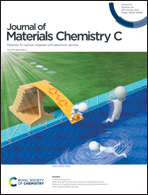Ammonium sulfate treatment at the TiO2/perovskite interface boosts operational stability of perovskite solar cells†
Abstract
Titanium dioxide (TiO2) electron transport layers (ETLs) are still widely used in perovskite solar cells (PSCs) due to their compatibility with existing printing technologies and favorable energy level alignment for efficient electron extraction. However, TiO2 ETLs suffer from surface defects, e.g. oxygen vacancies, that are detrimental to the perovskite/ETL interface stability, especially under operational conditions. Furthermore, hydroxyl groups present on the TiO2 surface also contribute to deprotonation of acidic organic cations in PSCs. We thus hypothesize that the metal oxide surface turns chemically reactive under 1-sun illumination whereby devices are highly populated with charge carriers and experience elevated temperatures (ca. 60 °C). Here, we introduced facile incorporation of sulfate species on the metal oxide surface to minimize chemical degradation at the perovskite/ETL interface. The sulfate treatment was found to minimally influence the perovskite film morphology grown on top of the ETLs, so ruling out morphological effects and allowing us to study the perovskite/ETL interface stability. We found that the sulfate treated devices exhibited enhanced operational stability under the initial maximum power point voltage (VMPP) over 1800 s of measurement. The sulfate treated devices retained 95% of their initial efficiency while the pristine devices already lost more than 40% of their initial efficiency. We also thermally aged encapsulated perovskite films coated on top of pristine and treated ETLs. We found that the thermally aged perovskite films coated on the pristine ETL contained perovskite hydrate species while the treated samples did not. We thus postulate that the water molecules contributing to hydrate formation were generated solely from the ETL/perovskite interface. Lastly, better energy alignment was also found between the perovskite and sulfate-treated ETL, which also contributes to the improved operational and thermal stability.



 Please wait while we load your content...
Please wait while we load your content...